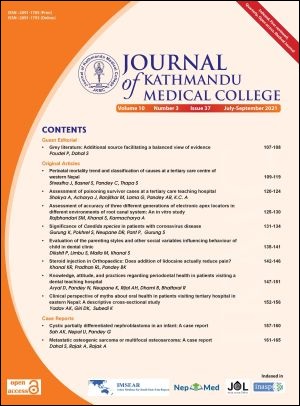Assessment of accuracy of three different generations of electronic apex locators in different environments of root canal system: An in vitro study
DOI:
https://doi.org/10.3126/jkmc.v10i3.41235Keywords:
Apex locator, Root canal, Working lengthAbstract
Background: Endodontic treatment encompasses cleaning, shaping, disinfection, and three-dimensional obturation of entire accurate length of root canal system. Hence, accurate determination of working length plays very important role for clinical success of endodontic treatment.
Objectives: To assess the accuracy of three different generations of electronic apex locators (EALs) in different environments of root canal system.
Methods: A descriptive cross-sectional study was done in 60 single-rooted mandibular premolars for three months from 2021/12/21 to 2021/03/18 at Kantipur Dental College. Non-carious teeth were collected (excluded if more than one canal) by convenience sampling after ethical clearance. Access opening with occlusal reduction of cusp tips were performed. Before, electronic measurement of root canal length, reference length: Actual Length (AL) was recorded. Samples were divided into four groups with different environment (I = dry Canal; II = 3% NaOCl; III = 2% CHX; IV = blood Plasma) with 15 samples each. Electronic measurements were obtained using all three EALs: Rootor (fourth generation), Propex Pixi (fifth generation), and Apex ID (sixth generation). Recorded AL was compared with value obtained with EALs and their differences were tabulated with Microsoft Excel.
Results: Accuracy in working length measurement by Rootor was 80%, 80%, 60%, 53.3%, Propex Pixi was 46.7%, 80%, 86.7%, and 100% and Apex ID was 100%, 93.3%, 86.7%, 100% in Group I, Group II, Group III, and Group IV respectively of AL.
Conclusion: Accuracy of Rootor was high in dry canal, Propex Pixi in moist environment whereas, Apex ID in both dry canal and moist environment.
Downloads
Downloads
Published
How to Cite
Issue
Section
License
Copyright © Journal of Kathmandu Medical College
The ideas and opinions expressed by authors or articles summarized, quoted, or published in full text in this journal represent only the opinions of the authors and do not necessarily reflect the official policy of Journal of Kathmandu Medical College or the institute with which the author(s) is/are affiliated, unless so specified.
Authors convey all copyright ownership, including any and all rights incidental thereto, exclusively to JKMC, in the event that such work is published by JKMC. JKMC shall own the work, including 1) copyright; 2) the right to grant permission to republish the article in whole or in part, with or without fee; 3) the right to produce preprints or reprints and translate into languages other than English for sale or free distribution; and 4) the right to republish the work in a collection of articles in any other mechanical or electronic format.




